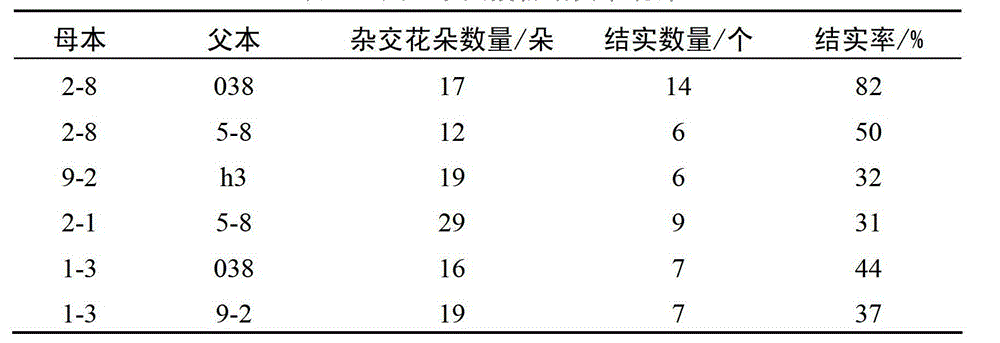Method for performing artificial crossbreeding without removing stamen from catalpa bungei and application thereof
A technology of artificial hybridization and catalpa, which is applied in the fields of application, botany equipment and methods, plant gene improvement, etc., can solve the problems of catalpa self-fertilization, catalpa not emasculation, inability to pollinate and bear fruit, etc., to reduce labor costs Strength, guaranteed efficiency effect
- Summary
- Abstract
- Description
- Claims
- Application Information
AI Technical Summary
Problems solved by technology
Method used
Image
Examples
Embodiment 1
[0021] In 2010, 3 individual plants of the catalpa test forest in Yanshi City, Henan Province were selected as female parents, and 2 individual plants were used as male parents for artificial pollination, which specifically included the following steps:
[0022] 1 pollen collection
[0023] Catalpa trees in Yanshi generally bloom after April 20. However, due to the low temperature in the spring of 2010, the flowering time was delayed by 1 week. After the catalpa blossomed on May 1, the development and changes of the anthers were observed in time. From May 5 to 6, when the anthers were swollen, the surface was milky white, and had a shiny luster, but the anthers were not cracked, the anthers were collected. Gently pick off the anthers from the stamens with medical tweezers, and place them in a clean glass petri dish (the size of the petri dish is selected according to the amount of pollen collected), avoiding direct sunlight. Then put the pollen in an air-conditioned room to ...
Embodiment 2
[0031] In 2009, 4 individual plants of the catalpa test forest in Tianshui City, Gansu Province were selected as female parents, and 4 individual plants were used as male parents for artificial pollination, which specifically included the following steps:
[0032] 1 Pollen Collection and Preservation
[0033] In Tianshui City, Catalpa generally blooms after May 5th. After the Catalpa blooms on May 7th, observe the development and changes of anthers in time. Collect anthers when they are not dehiscated. Gently pick off the anthers from the stamens with medical tweezers, and place them in a clean glass petri dish (the size of the petri dish is selected according to the amount of pollen collected), avoiding direct sunlight. Then put the pollen in an air-conditioned room to dry in the shade, and the room temperature is controlled at 20-22°C. After drying in the shade, the pollen was stored in a refrigerator at 4°C.
[0034] 2 artificial pollination
[0035] On May 12, the weat...
Embodiment 3
[0041] In 2011, 4 individual plants of the catalpa test forest in Tianshui City, Gansu Province were selected as female parents, and 3 individual plants were used as male parents for artificial pollination, which specifically included the following steps:
[0042] 1 Pollen Collection and Preservation
[0043] In Tianshui City, catalpa usually blooms after May 5th. After the catalpa blooms on May 7th, observe the development and changes of anthers in time. When the anthers are swollen from May 10th to 11th, the surface is milky white and has a shiny luster. , but not dehisced for anther collection. Gently pick off the anthers from the stamens with medical tweezers, and place them in a clean glass petri dish (the size of the petri dish is selected according to the amount of pollen collected), avoiding direct sunlight. Then put the pollen in an air-conditioned room to dry in the shade, and the room temperature is controlled at 20-22°C. After drying in the shade, the pollen was ...
PUM
 Login to View More
Login to View More Abstract
Description
Claims
Application Information
 Login to View More
Login to View More - R&D
- Intellectual Property
- Life Sciences
- Materials
- Tech Scout
- Unparalleled Data Quality
- Higher Quality Content
- 60% Fewer Hallucinations
Browse by: Latest US Patents, China's latest patents, Technical Efficacy Thesaurus, Application Domain, Technology Topic, Popular Technical Reports.
© 2025 PatSnap. All rights reserved.Legal|Privacy policy|Modern Slavery Act Transparency Statement|Sitemap|About US| Contact US: help@patsnap.com



